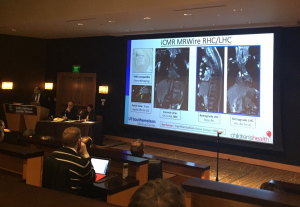Last February 7th to 9th, SCMR took place in snowy Seattle-Bellevue. Over 1000 CMR specialists gathered to discuss the newest insights into cardiac MRI. Nano4Imaging’s clinical director Paul Borm was present to co-brand our MRWire as EmeryGlide for the US market with our partner BBraun Interventional. During the interventional CMR session (Feb 7th) Nano4Imaging had a joint table with its new distributors to co-brand the EmeryGlide. During the various workshops several clients showed the enormous progress that MRI guided procedures have made, also by using our EmeryGlide guidewire.
MRI guidance takes off.
Drs Hussain, Arar and Reddy (Dallas Children’s/UT Southwestern) showed the results of over 30 pediatric cases revealing new procedures such as test occlusions in Fontan fenestration, and diagnostic procedures in single-ventricle patients. Dr Knight (RFH London) explained in detail how his hospital has meanwhile done 50 MRI guided pressure measurements in the pulmonary artery for diagnosis of PH in adult patients. The subsequent days, several taped cases were shown by the Dallas team to show the exact procedure that was used to cross the fenestration using the EmeryGlide and slide a balloon over it. MRI guidance has clearly taken off to the next level!


More exciting insights
Apart from the interventional take-off other topics such as artificial intelligence (deep learning) are really taking off in both diagnostics as well as in rapid calculation of results. In addition, 3D printing of hearts seems to become a reality in most centres of congenital heart disease. In some technical centers (Georgia Tech and Atlanta Emory Hospital) the 3D models are being used for further modelling studies such as 4D-flow. Interesting is also to note that the USA core facility on MRI guidance at NIH (dr Campbell, dr Lederman) is now exploring to use low-field MRI (0.5 T) and conventional medical devices to perform interventional pre-clinical work. At this low field magnetic field apparently also oxygen can be used as a contrast agent that allows blood mapping.

